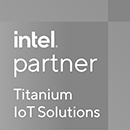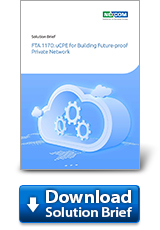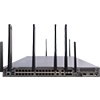FTA 1170: uCPE for Building Future-proof Private Network
The Trend
Network cloudification brings the required speeds and capacity for 5G-powered applications and services, fundamentally transforming the business world. The massive shift to smart manufacturing, smart office, and smart city made IoT an essential part of an organization. Recent statistics show that the number of global IoT connections grew by 8% in 2021 to 12.2 billion active endpoints, and market analysts are predicting further growth to an estimated 27 billion connected devices in 2025[1].
The data generated from billions of connected devices each day around the globe call for a different approach to handling information, and that is how the cloud comes into play in the new IT context. Meanwhile, the cloud has also evolved and separated into public cloud, private cloud, and hybrid cloud, each with a set of different attributes.

Public clouds utilize shared infrastructure, while private clouds utilize an own infrastructure of a company. Building one’s private network is not an easy task and requires investing a lot of time and money in network infrastructure. Other than budgetary concerns, the reasons to migrate workloads from the public to private clouds are:
Enhanced security: The traffic is limited to the organization’s transactions which gives better control over the server, network, and application security.
Flexibility: The private network allows an enterprise to customize it according to the enterprise's requirements, maximizing network efficiency.
Long-term savings: Investments in setting up network infrastructure will pay off in the long term.
Performance: Since the traffic flow through the enterprise's own physical infrastructure, fully dedicated to its needs, bandwidth will not be interfered.
The private cloud market is expected to maintain a compound annual growth rate (CAGR) of 29.6% and is estimated to reach a value of $205.4 billion by 2025[2]. Likewise, the private networks are predicted to grow a CAGR above 47.5% and reach a market value of around USD 36.08 billion by 2030[3], which will shape companies’ development and stability in the next few years.
The Challenge
When it comes to the challenges of building private network infrastructure, apart from the high costs incurred along the way, the very high demand for an enterprise’s IT department tops the list. For those with a lack of experience and knowledge in regards to this matter, it could be a "mission impossible".
The complexity of integrating the current business process of the company into the private cloud is in itself a very resource-consuming task. Not to mention the pressure to make the private cloud operate most efficiently without any security breach to deliver upon expectations.
Now, the enterprise has both data and assets to protect. As the owner of private cloud infrastructure, the enterprise (or the IT department) is accountable for high availability—making sure the network is up and running 24/7. The enterprise (or the IT department) is also responsible for the hardware maintenance even if that means replacing an old or malfunctioning COTS with a new one. When a current hardware upgrade is necessary, it has to be managed internally without the help of external professionals. Furthermore, security updates and protocol settings will also need to be done in-house from time to time.
NEXCOM Solution
In response to the growing demand for private cloud equipment NEXCOM has developed FTA 1170, a professional uCPE for wireless broadband applications. Its hardware design follows key requirements of CPE network compute platform specification, developed by AT&T, the world's largest telecommunications company, but with some improvements in terms of new technologies implementation.
FTA 1170 is a 1U rackmount appliance powered by Intel Atom® processor P5300 series, which provides a balance of power-efficient compute with enhanced integrated network applications. It features up to 24 cores – the highest core count among all current Intel Atom processor series, making FTA 1170 a perfect appliance for advanced packet processing and robust NFV and virtualization support. The onboard TPM module provides additional hardware-based security functions.
In terms of connectivity, FTA 1170 provides wired as well as wireless route. An impressive port count includes twenty-four 2.5GbE switch ports, four high bandwidth copper 10GbE NIC ports; high bandwidth fiber 10GbE switch and NIC ports, two of each type to reduce bottlenecks and data transfer latency. If customers require expansion or add additional ports to the appliance, its LAN module slot with a PCIe Gen3 interface can serve this purpose.
Wireless connectivity is an optional feature and brings expandability and flexibility to FTA 1170 users. The hardware design reserved a mini-PCIe slot for Wi-Fi 6, M.2 3052 Key B slot for the 5G FR1 module, making it possible to add wireless connectivity by installing a module. 5G connectivity provides seamless failover to 4G for the environments where the 5G signal is not stable.
Up to four PoE+ modules can be optionally installed, making FTA 1170 a power sourcing equipment (PSE), supplying power to up to 28 powered devices (PD). This function saves deployment costs and labor efforts in use cases where the place of installation has a limited quantity of power outlets and extension cables. In terms of safety, PoE uses relatively low voltages, reducing the risk of electrical hazards.
FTA 1170 is designed with high availability and serviceability. Redundant PSU prevents the system from interruption caused by single PSU failures. With the installation of the BMC module, FTA 1170 provides Out-of-band (OOB) remote management for a prompt response even during off-duty hours.
Conclusion
Overall, FT 1170 is endowed to become an essential part of private network infrastructure for many years ahead. Due to flexibility and expandability, it can be customized according to specific requirements. Optional features including, wireless connectivity, PoE capability, and OOB remote management each brings additional value to business operations.
FTA 1170 leverages Intel Atom® P5300 processor, which provides server-grade capabilities, shows leading performance per watt, and outstanding virtualization support. A combination of multiple switch ports and high bandwidth 10GbE NIC ports increases the max number of connected devices, making it a perfect appliance for use cases where mass IoT is involved. FTA 1170 can also operate as a MEC server, switch-server, or uCPE, and is born to fit for SD-WAN and other VNFs deployments.
|
|---|

References
[1] State of IoT—Spring 2022. https://iot-analytics.com/number-connected-iot-devices/
[2] Private Cloud Server Market Size, Share & Trend Analysis Report By Hosting Type (User Hosting, Provider Hosting), By Organization Type (SME, Large Enterprise), By Region, And Segment Forecasts, 2019 – 2025. https://www.grandviewresearch.com/industry-analysis/private-cloud-server-market
[3] Private 5G Network Market Size, Share & Trends Analysis Report By Component (Hardware, Software, Services), By Frequency (Sub-6 GHz, mmWave), By Spectrum, By Vertical, By Region, And Segment Forecasts, 2022 – 2030. https://www.grandviewresearch.com/industry-analysis/private-5g-network-market
- Related Links:
- Achieve Faster AI Insights with NEXCOM FTA 5190 and Xeon® 6 SoC
- NEXCOM Drives Edge AI, Dual 5G, and OT Security Innovation at CommunicAsia 2025
- Browse Other News:
- Smarter Healthcare Self-Service Starts with Neu-NE102 & XE104 Edge Computing
- NEXCOM Brings Expanded Edge, Security, and Quantum-Resistant Innovations to MWC Barcelona 2026
- All White Papers News


